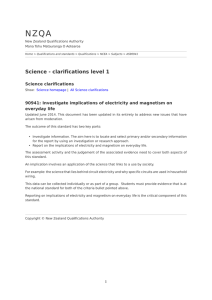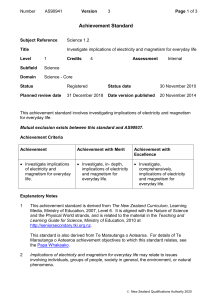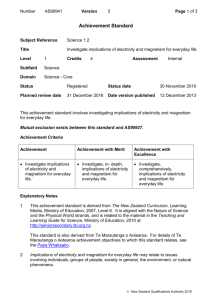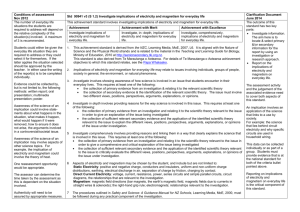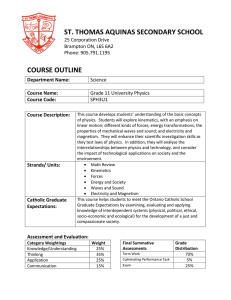90941 Investigate implications of electricity and magnetism
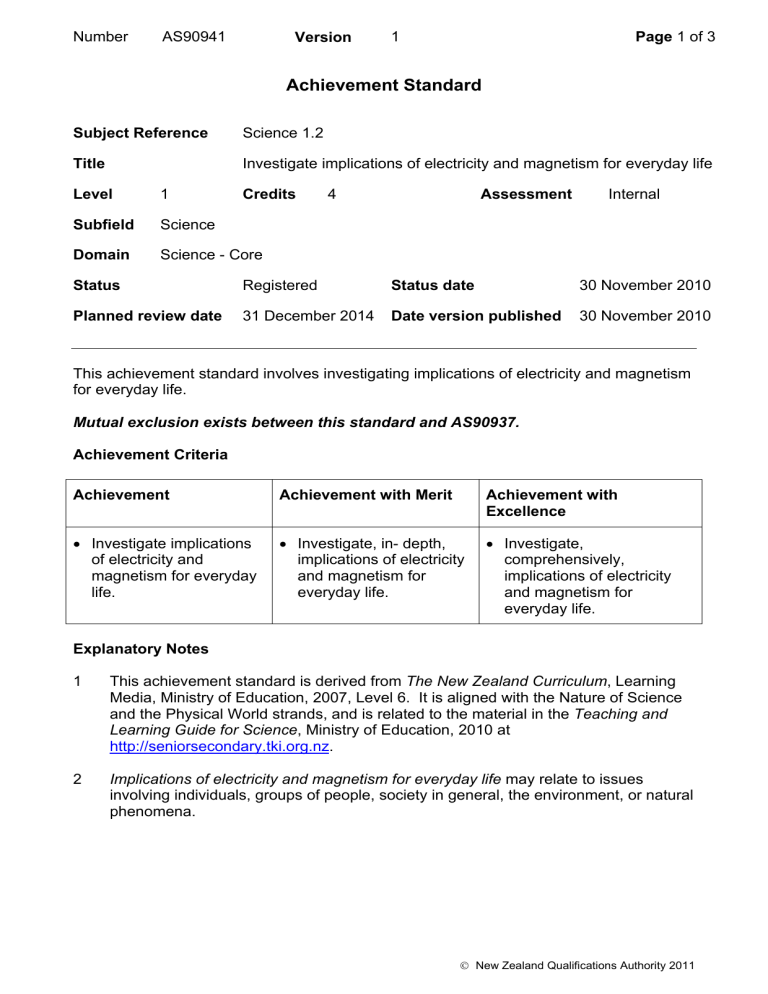
Number AS90941 Version 1
Achievement Standard
Subject Reference Science 1.2
Title
Page 1 of 3
Investigate implications of electricity and magnetism for everyday life
Level 1 Credits 4 Assessment Internal
Subfield Science
Domain Science - Core
Status Registered Status date 30 November 2010
Planned review date 31 December 2014 Date version published 30 November 2010
This achievement standard involves investigating implications of electricity and magnetism for everyday life.
Mutual exclusion exists between this standard and AS90937.
Achievement Criteria
Achievement Achievement with Merit Achievement with
Excellence
•
Investigate implications of electricity and magnetism for everyday life.
•
Investigate, in- depth, implications of electricity and magnetism for everyday life.
•
Investigate, comprehensively, implications of electricity and magnetism for everyday life.
Explanatory Notes
1 This achievement standard is derived from The New Zealand Curriculum , Learning
Media, Ministry of Education, 2007, Level 6. It is aligned with the Nature of Science and the Physical World strands, and is related to the material in the Teaching and
Learning Guide for Science , Ministry of Education, 2010 at http://seniorsecondary.tki.org.nz
.
2 Implications of electricity and magnetism for everyday life may relate to issues involving individuals, groups of people, society in general, the environment, or natural phenomena.
©
New Zealand Qualifications Authority 2011
Number AS90941 Version 1 Page 2 of 3
3 Investigate involves showing awareness of how science is involved in an issue that students encounter in their everyday lives. This requires at least one of the following:
•
the collection of primary evidence from an investigation and relating it to the scientific theory relevant to the issue
•
the collection of secondary evidence and the identification of the scientific theory relevant to the issue under investigation. The issue must involve two different views, positions, perspectives, arguments, explanations, or opinions.
4 Investigate in depth involves providing reasons for the way science is involved in this issue. This requires at least one of the following:
•
the collection of primary evidence from an investigation and relating it to the scientific theory relevant to the issue in order to give an explanation of the issue being investigated
•
the collection of sufficient relevant secondary evidence and the application of the identified scientific theory relevant to the issue to explain the different views, positions, perspectives, arguments, explanations, or opinions of the issue under investigation.
5 Investigate comprehensively involves providing reasons and linking them in a way that clearly explains the science that is involved in this issue. This requires at least one of the following:
•
the collection of primary evidence from an investigation and relating it to the scientific theory relevant to the issue in order to give a comprehensive and critical explanation of the issue being investigated
•
the collection of sufficient relevant secondary evidence and the application of the identified scientific theory relevant to the issue to critically evaluate the different views, positions, perspectives, arguments, explanations, or opinions of the issue under investigation.
6 Aspects may be chosen by the student, and include but are not limited to:
Static Electricity: positive and negative charge, conductors and insulators, uniform and non-uniform charge distributions, earthing, electrical discharge in air, separation of charge by friction, charging by contact.
Direct Current Electricity: voltage, current, resistance, power, series circuits and simple parallel circuits, circuit diagrams, the relationships that are relevant to the investigation.
Magnetism: magnetic field directions (bar magnets, the earth’s magnetic field, magnetic fields due to currents in straight wires and solenoids); the right-hand grip rule; electromagnets; the relationships that are relevant to the investigation.
7 The procedures outlined in Safety and Science: A Guidance Manual for New
Zealand Schools , Learning Media, Ministry of Education, 2000, must be followed during any practical component of the investigation.
8 Conditions of Assessment related to this achievement standard can be found at www.tki.org.nz/e/community/ncea/conditions-assessment.php
.
©
New Zealand Qualifications Authority 2011
Number AS90941 Version 1 Page 3 of 3
Replacement Information
This achievement standard replaced unit standard 6370.
Quality Assurance
1 Providers and Industry Training Organisations must be accredited by NZQA before they can register credits from assessment against achievement standards.
2 Accredited providers and Industry Training Organisations assessing against achievement standards must engage with the moderation system that applies to those achievement standards.
Accreditation and Moderation Action Plan (AMAP) reference 0233
©
New Zealand Qualifications Authority 2011
